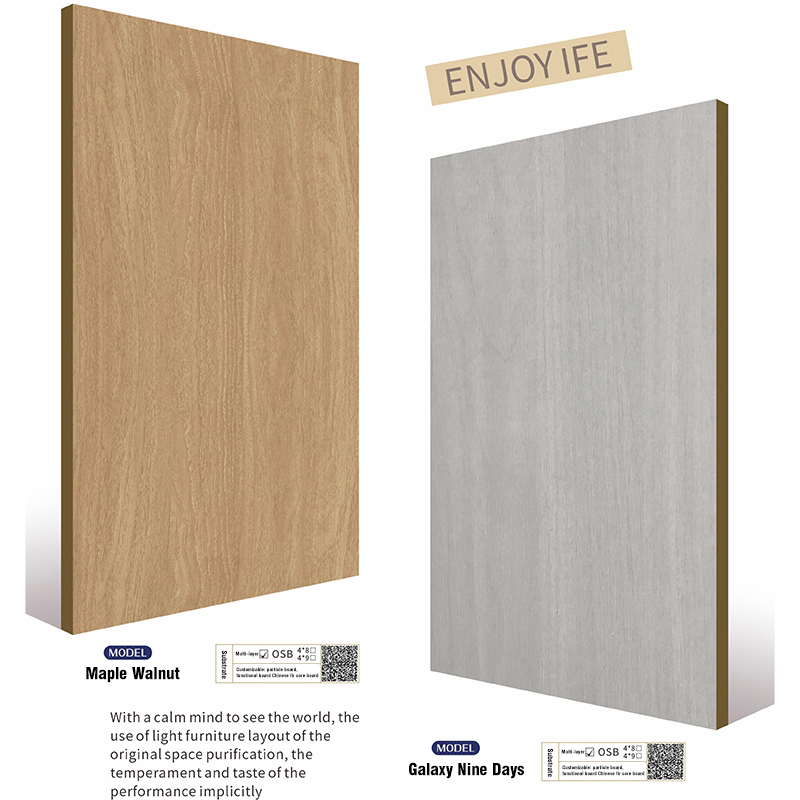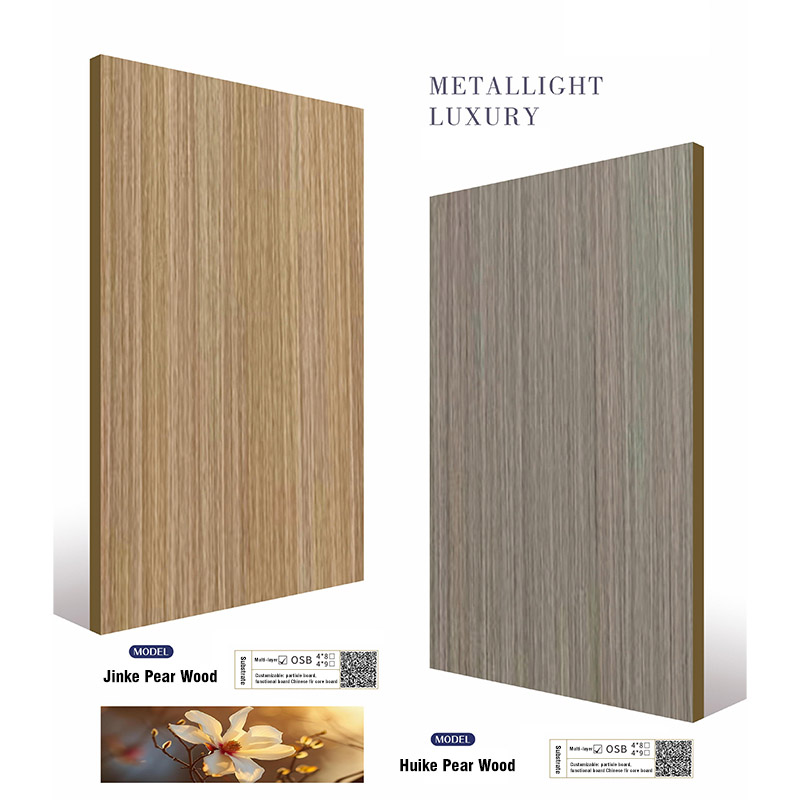What unique advantages does the moderate hardness of semi-light wood grain board substrate offer in terms of scratch resistance?
Release Time : 2025-11-05
In contemporary interior decoration, semi-light wood grain board substrate, due to its natural and warm visual effect and excellent processing performance, has become a preferred material for wall, cabinet, and furniture cladding in homes, offices, and even public places such as shopping malls and hotels. Its popularity stems not only from its aesthetic value but also from the unique scratch resistance provided by the moderate hardness of its substrate—neither too soft and easily damaged, nor too hard and brittle, striking a perfect balance between aesthetics, durability, and practicality.
1. Moderate Hardness: Finding the Golden Balance Between "Softness" and "Strength"
The hardness of wood or engineered wood is usually referenced to James hardness or Mohs hardness. Semi-light wood grain boards often use engineered/natural composite substrates such as oak, ash, birch, or high-quality melamine veneer, whose hardness falls within the moderate range. This level of hardness means that the surface is not easily scratched by minor friction or scratches from keys, tableware, or furniture movement during daily use; at the same time, due to its certain degree of toughness, it is not prone to chipping or cracking upon impact. In contrast, overly soft wood is easily scratched, while overly hard but brittle materials may flake off in fragments upon sharp impact. The "moderate hardness" of semi-light wood grain panels represents the ideal state for scratch resistance.
2. Synergistic Enhancement of Surface Treatment: The veneer layer and the substrate work together to form a protective barrier
Modern semi-light wood grain panels generally use melamine-impregnated paper, UV lacquer, or water-based wood coatings for surface coating. These veneer layers themselves have a high abrasion resistance rating, effectively resisting daily wear and tear. The moderate hardness of the substrate provides stable support for the veneer layer—if the substrate is too soft, the veneer is prone to blistering and peeling due to deformation of the underlying layer; if it is too hard and brittle, the veneer is prone to cracking along with the substrate. The moderately hard substrate and highly wear-resistant finish form a composite structure that combines rigidity and flexibility, evenly distributing and absorbing scratch force, greatly delaying the appearance of surface damage and maintaining a new look for a long time.
3. Real-world application verification: The first choice for public spaces that balance aesthetics and durability
In home environments, semi-light-colored wood grain panels are often used in high-touch areas such as cabinet doors, dining tables, and desks. Their scratch resistance effectively withstands everyday challenges such as children's drawings, pot and pan collisions, and stationery friction. In public places with high traffic and heavy use, this material also performs excellently. Even after long-term frequent touching, pushing, pulling, or cleaning, the surface maintains a clear wood grain and overall texture, avoiding a "worn-out" look due to accumulated scratches, significantly reducing maintenance and replacement costs.
4. Processing stability contributes to long-term scratch resistance
The product features mention "not easily deformed when properly processed," which indirectly contributes to its scratch resistance. If the wood grain board warps, expands, or contracts under changes in temperature and humidity, it will cause stress concentration in the veneer layer, resulting in micro-cracks at the edges or joints, which in turn accelerates the spread of scratch damage. Semi-light wood grain board substrates, however, have a stable structure and, after proper drying and pressing processes, exhibit low dimensional change, ensuring the veneer remains flat and tightly adhered to the substrate for a long time, without bulging or delamination, fundamentally maintaining its complete protective capability.
5. Unity of Aesthetics and Function: The "Invisible" Scratch Resistance Advantage of Light Colors
Semi-light wood grains inherently possess the advantages of visual softness and a bright atmosphere, but light colors tend to show scratches more easily. Therefore, the scratch resistance of both the substrate and the veneer is particularly important. Thanks to the good surface integrity resulting from moderate hardness, even under strong light or close observation, signs of daily use are minimal and can be restored with simple cleaning or polishing, avoiding the embarrassment of "getting old with use" and truly achieving a "lasting new" decorative effect.
The moderate hardness of semi-light wood grain board substrate is not a technological compromise, but rather a precise control based on a deep understanding of materials science and usage requirements. Its unique advantages in scratch resistance—combining toughness against daily wear and tear, stability to support highly wear-resistant finishes, and long-term aesthetic appeal—make it an ideal choice for modern decorative projects that balances aesthetics and durability. Whether in a cozy home or a busy public space, this wisdom of "strength and flexibility" silently safeguards the quality and style of the space.
1. Moderate Hardness: Finding the Golden Balance Between "Softness" and "Strength"
The hardness of wood or engineered wood is usually referenced to James hardness or Mohs hardness. Semi-light wood grain boards often use engineered/natural composite substrates such as oak, ash, birch, or high-quality melamine veneer, whose hardness falls within the moderate range. This level of hardness means that the surface is not easily scratched by minor friction or scratches from keys, tableware, or furniture movement during daily use; at the same time, due to its certain degree of toughness, it is not prone to chipping or cracking upon impact. In contrast, overly soft wood is easily scratched, while overly hard but brittle materials may flake off in fragments upon sharp impact. The "moderate hardness" of semi-light wood grain panels represents the ideal state for scratch resistance.
2. Synergistic Enhancement of Surface Treatment: The veneer layer and the substrate work together to form a protective barrier
Modern semi-light wood grain panels generally use melamine-impregnated paper, UV lacquer, or water-based wood coatings for surface coating. These veneer layers themselves have a high abrasion resistance rating, effectively resisting daily wear and tear. The moderate hardness of the substrate provides stable support for the veneer layer—if the substrate is too soft, the veneer is prone to blistering and peeling due to deformation of the underlying layer; if it is too hard and brittle, the veneer is prone to cracking along with the substrate. The moderately hard substrate and highly wear-resistant finish form a composite structure that combines rigidity and flexibility, evenly distributing and absorbing scratch force, greatly delaying the appearance of surface damage and maintaining a new look for a long time.
3. Real-world application verification: The first choice for public spaces that balance aesthetics and durability
In home environments, semi-light-colored wood grain panels are often used in high-touch areas such as cabinet doors, dining tables, and desks. Their scratch resistance effectively withstands everyday challenges such as children's drawings, pot and pan collisions, and stationery friction. In public places with high traffic and heavy use, this material also performs excellently. Even after long-term frequent touching, pushing, pulling, or cleaning, the surface maintains a clear wood grain and overall texture, avoiding a "worn-out" look due to accumulated scratches, significantly reducing maintenance and replacement costs.
4. Processing stability contributes to long-term scratch resistance
The product features mention "not easily deformed when properly processed," which indirectly contributes to its scratch resistance. If the wood grain board warps, expands, or contracts under changes in temperature and humidity, it will cause stress concentration in the veneer layer, resulting in micro-cracks at the edges or joints, which in turn accelerates the spread of scratch damage. Semi-light wood grain board substrates, however, have a stable structure and, after proper drying and pressing processes, exhibit low dimensional change, ensuring the veneer remains flat and tightly adhered to the substrate for a long time, without bulging or delamination, fundamentally maintaining its complete protective capability.
5. Unity of Aesthetics and Function: The "Invisible" Scratch Resistance Advantage of Light Colors
Semi-light wood grains inherently possess the advantages of visual softness and a bright atmosphere, but light colors tend to show scratches more easily. Therefore, the scratch resistance of both the substrate and the veneer is particularly important. Thanks to the good surface integrity resulting from moderate hardness, even under strong light or close observation, signs of daily use are minimal and can be restored with simple cleaning or polishing, avoiding the embarrassment of "getting old with use" and truly achieving a "lasting new" decorative effect.
The moderate hardness of semi-light wood grain board substrate is not a technological compromise, but rather a precise control based on a deep understanding of materials science and usage requirements. Its unique advantages in scratch resistance—combining toughness against daily wear and tear, stability to support highly wear-resistant finishes, and long-term aesthetic appeal—make it an ideal choice for modern decorative projects that balances aesthetics and durability. Whether in a cozy home or a busy public space, this wisdom of "strength and flexibility" silently safeguards the quality and style of the space.







